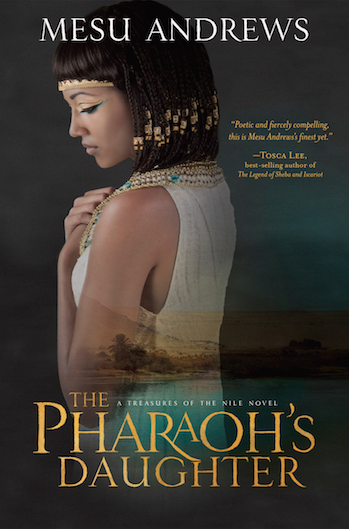 The Pharaoh's Daughter by Mesu Andrews
The Pharaoh's Daughter by Mesu Andrews Series: Treasures of the Nile #1
Publisher: WaterBrook Press (2015)
eARC, Paperback (384 pages)
Via: Blogging for Books
Rating:
Also by this author: Miriam, Isaiah's Daughter, Isaiah's Legacy
Also in this series: Miriam
Reading Challenges: Read 2015
Synopsis
“You will be called Anippe, daughter of the Nile. Do you like it?” Without waiting for a reply, she pulls me into her squishy, round tummy for a hug.
I’m trying not to cry. Pharaoh’s daughters don’t cry.
When we make our way down the tiled hall, I try to stop at ummi Kiya’s chamber. I know her spirit has flown yet I long for one more moment. Amenia pushes me past so I keep walking and don’t look back.
Like the waters of the Nile, I will flow.
Anippe has grown up in the shadows of Egypt’s good god Pharaoh, aware that Anubis, god of the afterlife, may take her or her siblings at any moment. She watched him snatch her mother and infant brother during childbirth, a moment which awakens in her a terrible dread of ever bearing a child. Now she is to be become the bride of Sebak, a kind but quick-tempered Captain of Pharaoh Tut’s army. In order to provide Sebak the heir he deserves and yet protect herself from the underworld gods, Anippe must launch a series of deceptions, even involving the Hebrew midwives—women ordered by Tut to drown the sons of their own people in the Nile.
When she finds a baby floating in a basket on the great river, Anippe believes Egypt’s gods have answered her pleas, entrenching her more deeply in deception and placing her and her son Mehy, whom handmaiden Miriam calls Moses, in mortal danger.
As bloodshed and savage politics shift the balance of power in Egypt, the gods reveal their fickle natures and Anippe wonders if her son, a boy of Hebrew blood, could one day become king. Or does the god of her Hebrew servants, the one they call El Shaddai, have a different plan—for them all?
Find the book: Goodreads
My Review
This is the story of Anippe. She is the daughter of one pharaoh, sister to another, and adoptive daughter to yet another. She is an important person in Egypt as a member of the dwindling royal house.
After her mother’s death, Anippe’s father, the current pharaoh, allows his general to adopt her. Her older brother, Tut, stays with their father as his heir and their younger sister, Ankhe, is basically ignored because she doesn’t act befitting an Egyptian princess.
A few years after young Tut becomes pharaoh, Anippe is married to an honorable captain in her brother’s army named Sebak. Sebak has an estate in the delta region of Egypt. It is on this estate that Anippe first comes into contact with Hebrew slaves.
In retaliation for his wife’s two miscarriages while visiting Anippe, Tut orders that all male Hebrew babies are to be killed. When Tut and Sebak leave after the wedding celebrations, Anippe is left alone with Ankhe and the Hebrew slaves.
Not long after Sebak has left for war, Anippe is grieving him the her private bathhouse when she sees a basket floating in the reeds. The basket holds a Hebrew male child and Anippe forms a plan. She never wanted to give birth because childbirth claimed the life of her mother and very nearly the life of her brother’s wife. Her deception involves passing off the Hebrew child as an Egyptian prince.
The Pharaoh’s Daughter ends with Mehy (Moses) still a young man, years before he would return to free the slaves. The story focuses on Anippe before she adopted Moses and following with her struggles. Anippe is a very strong woman who would do anything for Mehy, the child she pulled from the Nile.
I enjoyed reading this book. There were some twists that I did not expect. Apparently I need to reread the book of Exodus. 🙂
Catholic Connections
*Spoiler Alert*
In order to analyze the text and make these connections, there may be some spoilers.
Please do not continue reading unless you have already read the book
or you don’t mind if you read some spoilers.
*Spoiler Alert*
As this is a fictional account of what may have happened surrounding Moses’s birth, I think that itself is a Catholic Connection.
I also see, in a way, a connection between St Jospeh and Mered. Mered is the chief linen keeper of Sebak’s estate. He genuinely cares about his master’s well-being and later about Anippe as well. He puts aside his grief for his dead wife to provide a mother for his children and safety for Anippe. He is as selfless as I think St Joseph must have been to put aside everything to keep Mary and Jesus safe.
I know that this comparison is not perfect and I doubt the author intended such connections. This is simply my own opinion.
Which Reading Challenges?
- You Read How Many Books? Reading Challenge

I received this book for free from the publisher via Blogging for Books for review consideration. This in no way affects my opinion of the title nor the content of this review.






Leave a Reply